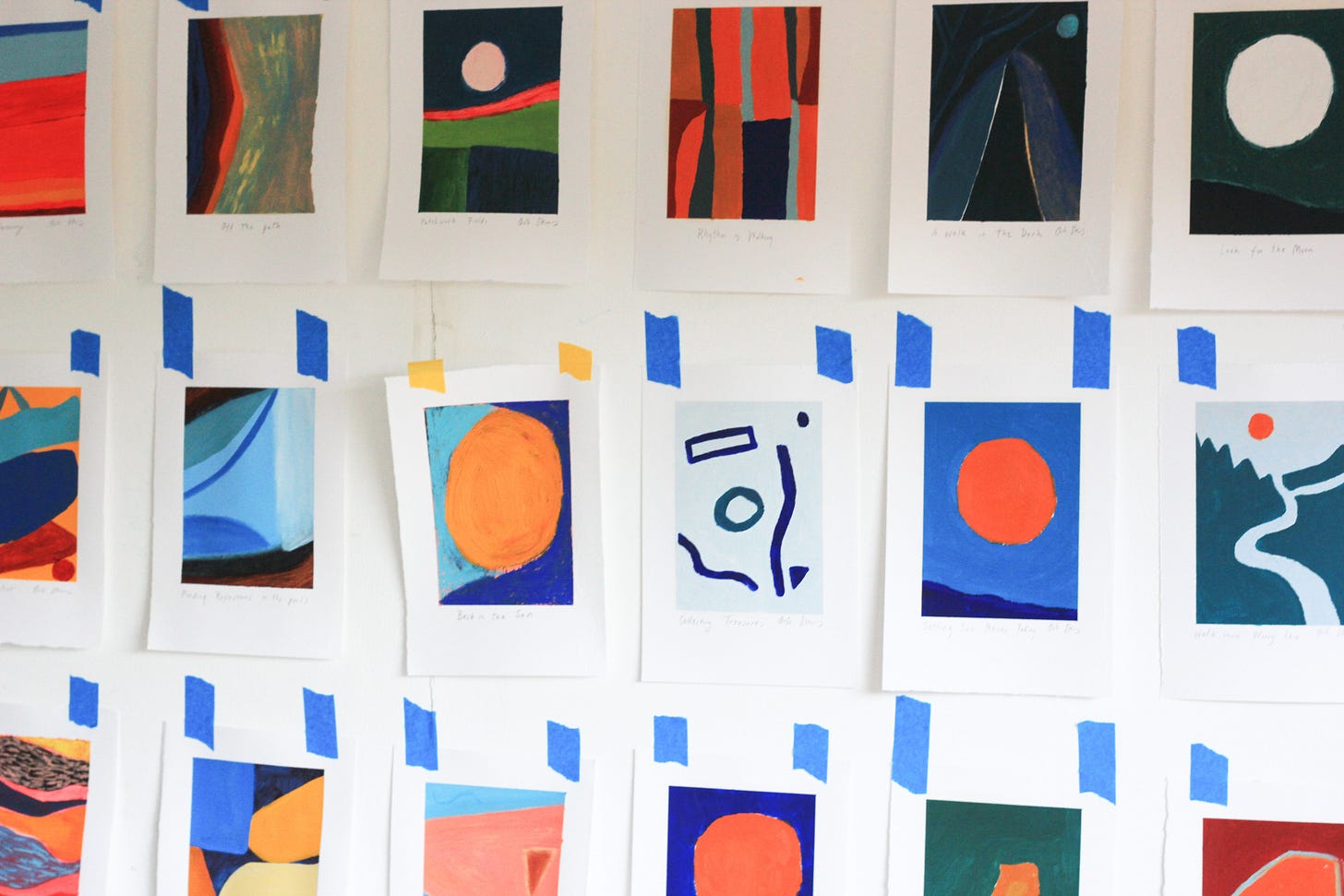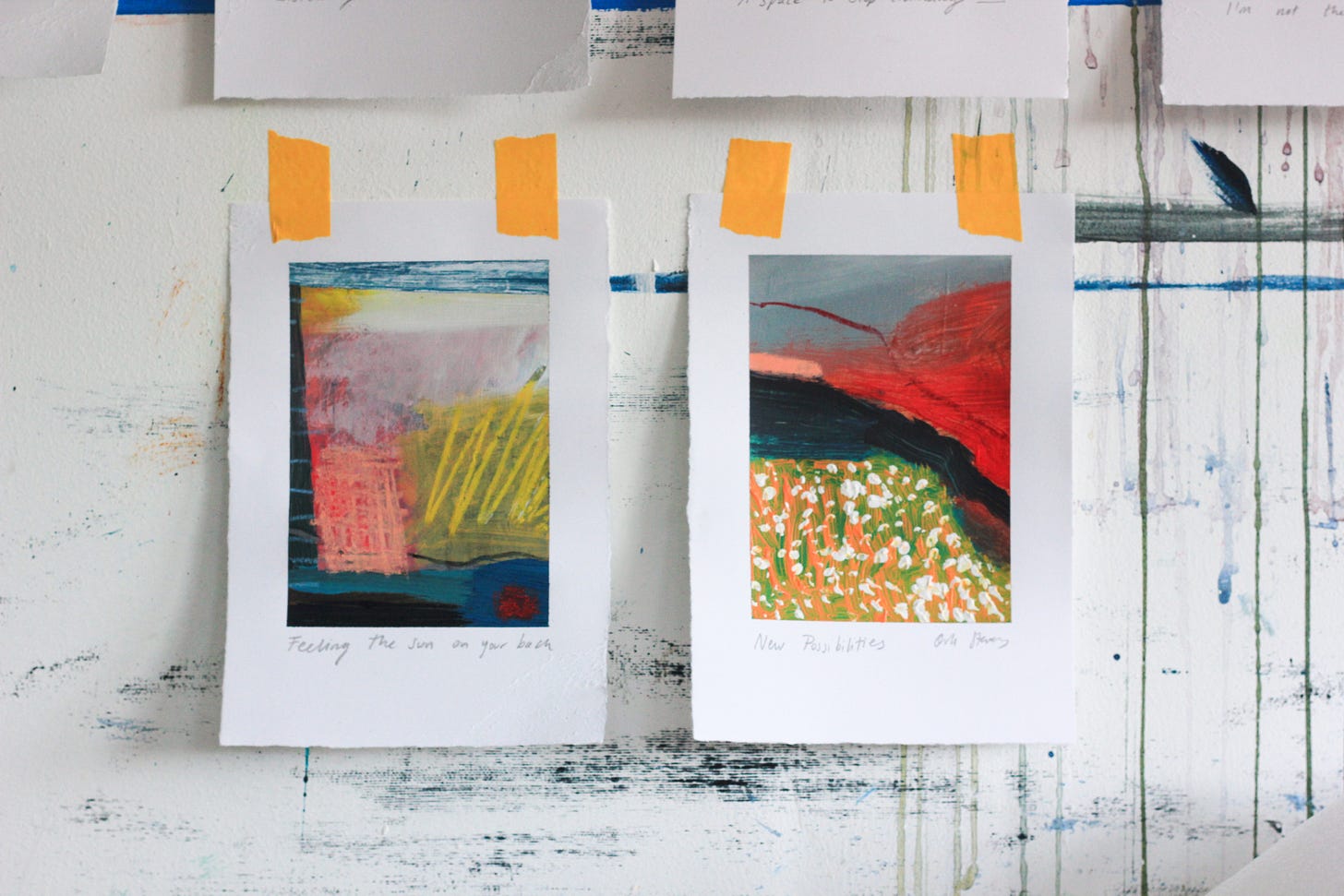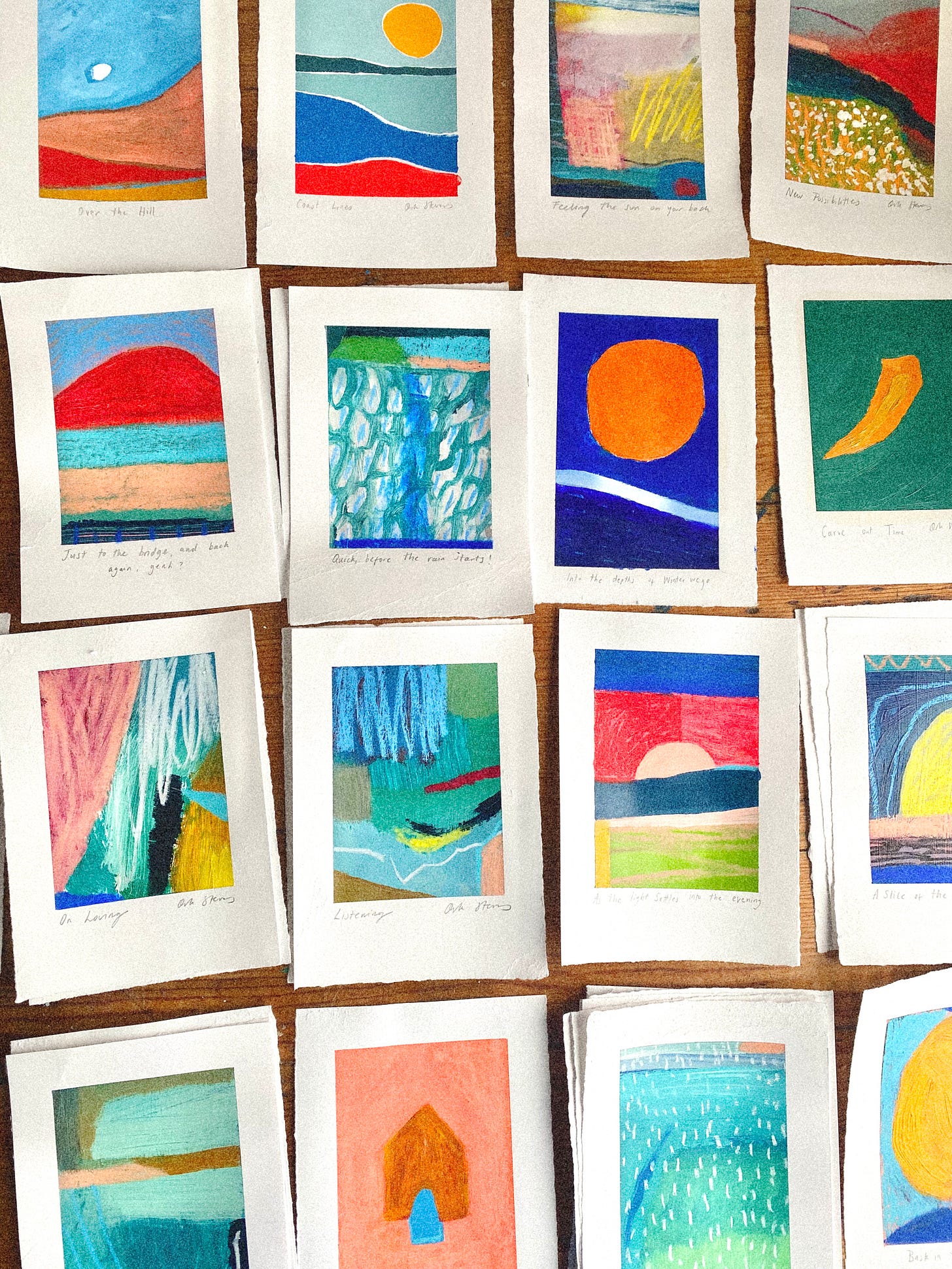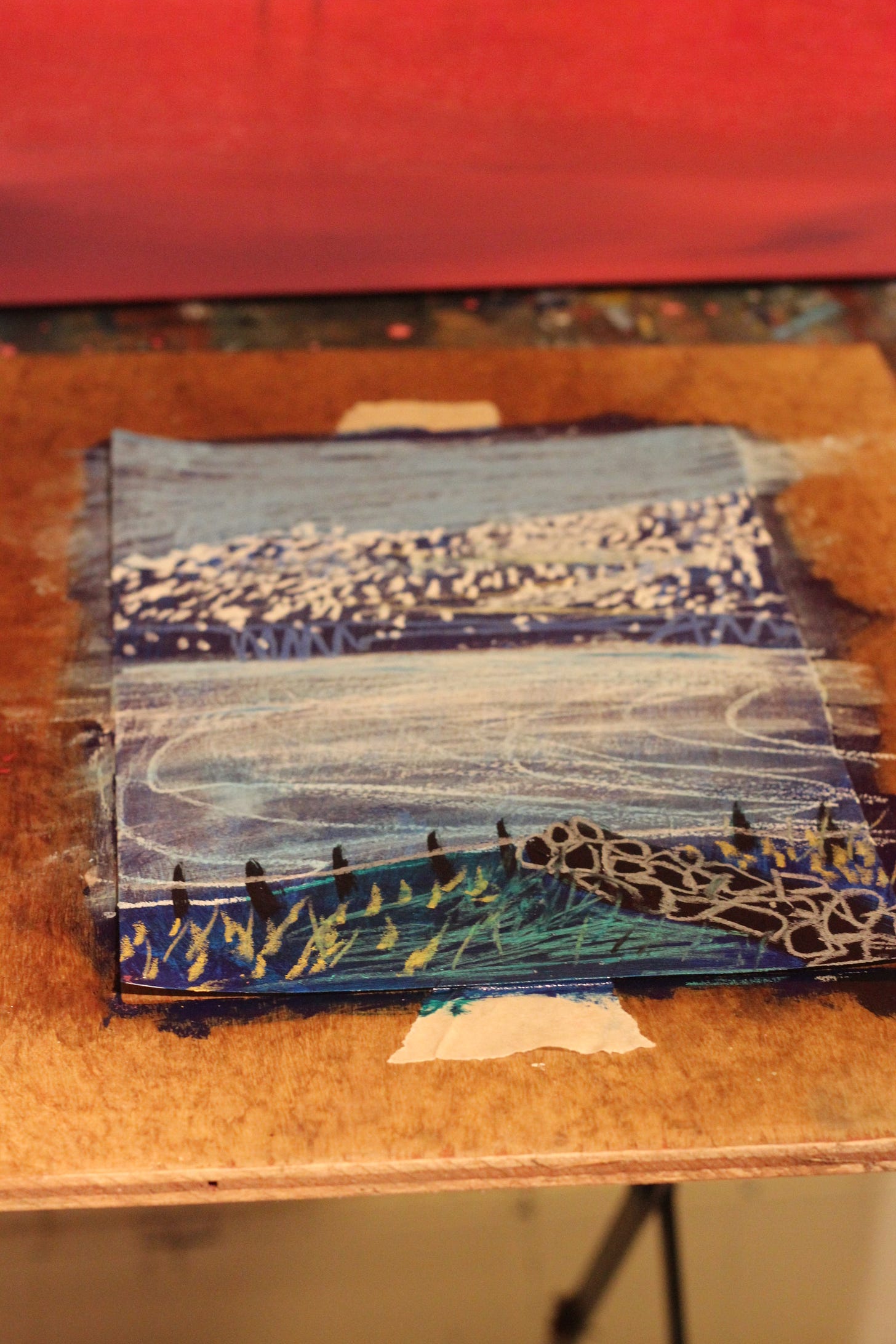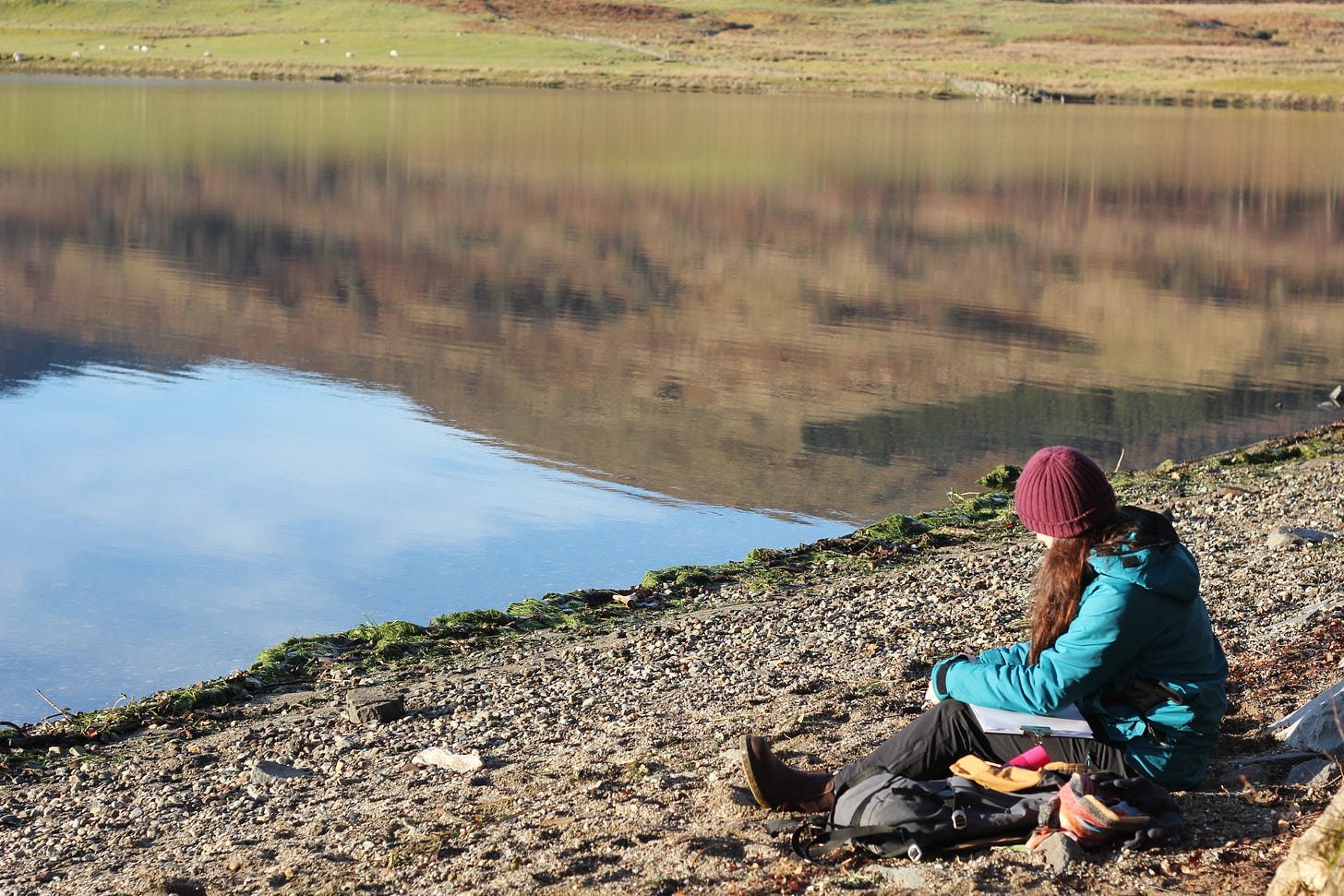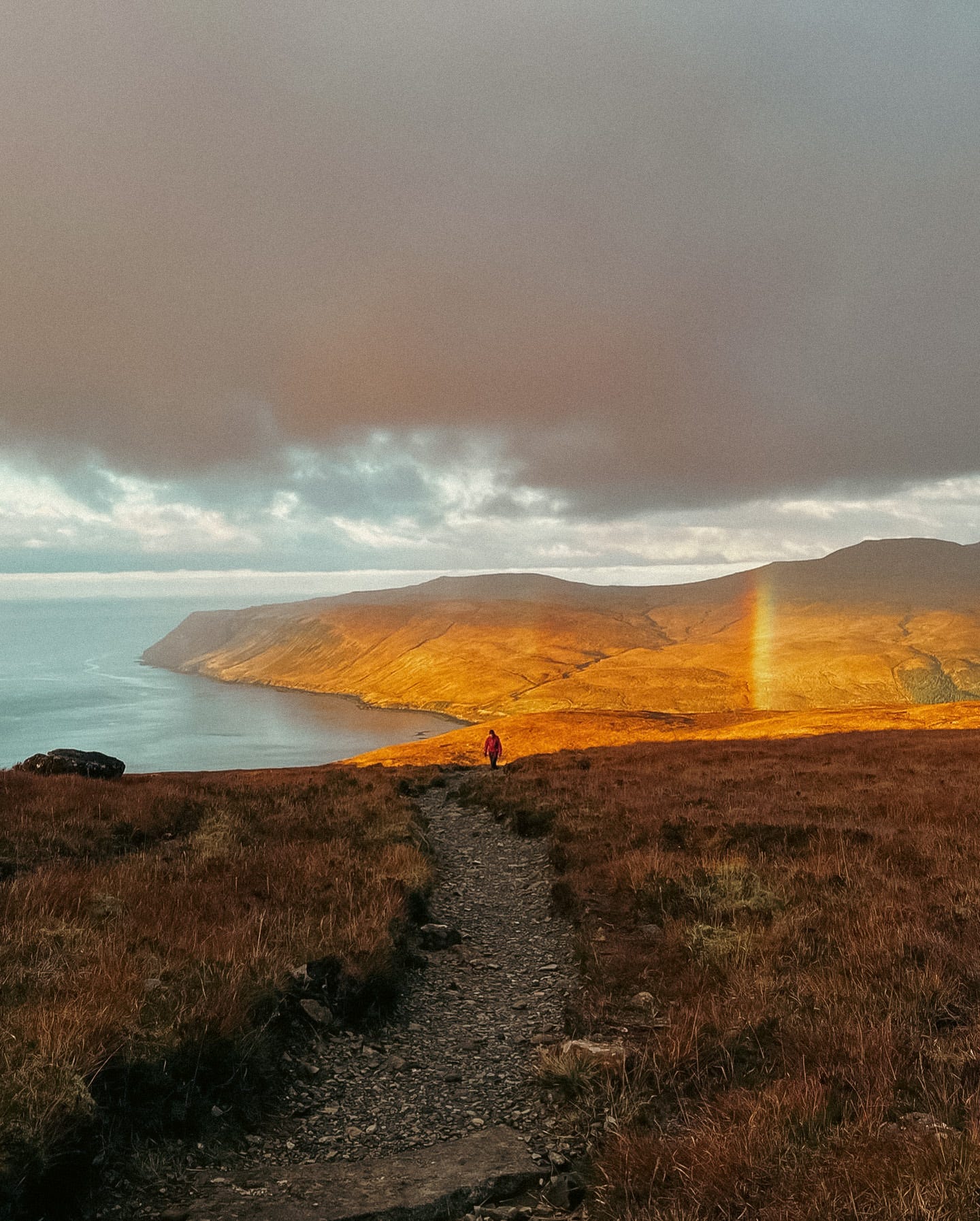How I've been overcoming Creative Block
Overwhelm in painting & the power of personal projects
If you’re new to a creative process and feeling overwhelmed, or have been working away for years and found yourself feeling a little bit stuck, welcome! This is a feeling that visits time and time again in a creative practice, and it’s been a mission of mine to find ways to embrace it, and then move forwards: so that I can create work regularly in a way that suits me and feels good.
First up; if you’re feeling stuck or blocked, instead of jumping to push straight through to solutions, it’s probably worth sitting for a minute to understand why you’re feeling stuck or overwhelmed in your creative practice. Before you read any further, just hit pause and see if there are any specifics that jump to mind.
We all know there are so many external reasons to feel overwhelmed - family life, working, the general daily juggling act. It’s easy to impact our work, and it can be hard to create when you’ve very little headspace. Hopefully some of these practical pointers and structures can help guide you to a place that’s more focused and free.
I’ve been working away on a new series of paintings, and I’ve been really settling in to this focused personal project. There’s been a handful of factors helping me find a groove in this current personal project, and I wanted to take a moment to share what’s been working for me with you.
From how I structure my studio sessions, to how I’ve been using creative rules and briefs to break through creative block or overwhelm - and just get painting.
If you’re new here, my name is Orla, and I’m a freelance artist, illustrator and designer who’s other big love outside of art is nature and the outdoors. I make fine art, teach, design products and make films - all about creativity and nature: often bringing my work outside.
So, what am I working on in the studio at the moment?
Right now, I’m creating a series I’ve titled ‘Finding Nature’. I actually started this project back in the beginning of 2023 with a series of around 50 original paintings on paper. The idea was to create paintings at a small scale: A5 on paper, to quickly generate ideas. I’m the kind of painter who feels that the bigger is always more fun, so it was technically challenging for me to scale down my work. The benefit? It was much more practical and less time consuming to create work. Working small scale also meant I could do a few, put them away, and come back to the project whenever I felt like it. For some reason, working smaller felt - at this stage - less daunting. I let myself free flow: making abstract paintings that were patterns, shapes, landscapes - anything that took my fancy. The first round focused on creating abstract paintings using words as a starting point. I had pieces titled everything from ‘Heart Rate Walking Up Hill’ to ‘Feeling the Sun on Your Back’. I wanted the work to be about relatable human experiences - moments we’ve all felt outdoors. I took words from my journal and gathered phrases from friends. Things that connect us together, and to our favourite environments.
Fast forward to now - July 2023 - I’ve been feeling that creative itch to just let loose again and explore freely. It might feel like a contradiction to say that this post is actually all about rules and limitations, but bear with me and I’ll share how these things have been my secret to creating with freedom. I think this creative itch and general unsettled feeling was the result of building a big body of work earlier in the year. I worked towards my solo show ‘Playgrounds’ which was held in June 2023. Having a focused project and deadline always leaves me feeling the need to just make for the sake of making afterwards. I remembered how much I loved making this series, and have decided to come back to the page format and project structure. I’ve made a full video introducing this Finding Nature 2.0 in full, which you can check out here.
Whilst I’ve been developing this series again, I’ve been noticing some patterns in the way I structure my studio sessions. Having been painting full time for the last five years, I’ve really settled in to my ways of working, and I thought that sharing some behind the scenes into my structure and process might spark some ideas for you to try too, to get the most out of your own painting, drawing or creating sessions, whatever the medium. As ever, feel free to do the opposite, and take and leave what fits.
Planning & forming a Brief
Before I get cracking with painting, I love to do some writing to help me focus in on what I’m looking to explore. From my background in design, I like to write loose briefs which help me structure my painting sessions. I find this a great way to avoid overwhelm, which I find can be especially easy to fall into with abstract painting.
I write out the aims of my painting session, the feelings I want the work to explore, and the experiments I want to try. After I’ve written out bullet points for these three things, I like to write out one final sentence that summarises my focus.
In this session, I aimed to explore icons and motifs. The feelings I wanted the work to capture were all about play, exploration, wonder and adventure. You know that feeling of discovery you get when you learn something new? This is what I love so much about being in the outdoors, and what I celebrate in my work. Walking outside and finding something new in the familiar of nature gives me a real sense of peace and excitement at the same time.
Feelings and emotions drive my use of colour, which help me choose the palette I’m using. I picked colours that married the feelings I was looking to capture. The experiments were using gouache - a medium I’m relatively new to: acrylic being my medium of choice.
Finding yourself through repetition
I love working on many paintings at once. The physical painting process really inspires my work, along side landscape and everything else I’m interested in. I take ideas from the marks as I make them, and improvise with them as I paint - so hopping between pieces and working quickly helps bring energy and rhythm to my work, as well as keeping it fresh.
My approach to painting is all about improvisation. Whilst it might look like wild abandon, I have set rules, materials, movements and marks which all hold meaning for me. Within these exercises and frameworks, I let myself be free to explore how they interact. The rules and brief give me structure within which I can be loose and experimental, and play. I suppose the rules are like my own playground - a safe and contained space to explore.
I love having a reason for every action I take in my art. This might be conscious, it might be led by an emotion, informed by something factual, a reference to a place, fact, person. Understanding why I make marks and choices in my work helps build meaning, which is important to me and my reason for making.
I think that making high volumes of work has helped me find my current creative voice. If you create 50 paintings in a row, you’re bound to notice things you love, and love less-so in the works. If you can continue to create and look honestly, your voice and style will surface through time and practice.
Consistency
I find that pre-selecting my materials, colours and tools helps build consistency in my paintings and avoids that pesky overwhelm. Again, the rule of limited materials helps you push to explore new ways of working within limitations - leading to new innovations and discoveries. Having a limited selection of tools and materials to work with really helps with overwhelm.
Choose two to three of your favourite mediums: one type of paint, and one to two drawing tools. For me, this looks typically like acrylic, oil pastel and either charcoal or soft pastel. I’ve naturally developed a colour palette over the years of practicing which are personal to me, my experiences and my painting practice. If you’re looking to start exploring colour, I find it really helpful to select a limited palette of 3 to 4 colours, and explore how they work together, before adding more. Colour is central to my work and I’m a little bit obsessed with exploring it’s emotive powers. Check out my blog post focusing on my approaches to colour here.
Getting Started
For me there’s nothing worse than a blank piece of paper. I love to add washes of colour, marks or textures to my paper before I begin the work. This takes the fear out of starting, and lets me warm up with no pressure. I like to try different base colours so I can explore how the following colours and materials react as they build. For me, the more layers the better - even if it gets totally covered up, these layers add depth to each painting. Sometimes I deliberately make this first layer ugly, or use difficult colours, so that I can use the following layers of the painting to problem solve back to a place of harmony and balance.
Whilst I’m waiting for the base colour washes to dry, I sometimes do some sketches. I make these thumbnails occasionally, to get thinking of shapes, colours, marks or compositions that I attribute to my brief. Sometimes they are sections of previous paintings that I like and want to explore at a larger scale. Being honest, most of the time I ignore these preliminary ideas, and just follow my nose as soon as I pick up the brush. However, it’s good to have them out of my head so I can reference them in the future.
It’s important that I never feel bound to these initial sketches - sometimes having a full plan for a painting removes the improvisation, and all the fun of the unknown - It only leads to disappointment when I can’t create the fixed idea in my head. If I plan too much, I’ve created a right and a wrong, which only leads to more tension in the work and things fall apart. It’s better to start out with a rough direction, and let the painting tell me where it wants to go from there.
Control
Painting is such a funny balance of control. There’s total control needed over the medium - an understanding of how materials react in thousands of iterations, combinations and applications. It’s like having a library of processes and predictions in your head: here in lies the skill, or craft of painting. There’s the control of focus, of knowing how to get yourself into a place of flow, or at least, the discipline to paint regularly. And then, there’s the need to have very little control, and trust in the process and your experience to create something meaningful. It’s this balance of trust and control which comes with practice and time.
Habits
I find it so intriguing to learn about people’s habits. I love learning about other artists processes and ways of working in the studio. Everyone develops a practice that is so personal to them, and you can learn lots about a person from their daily habits. I think a studio practice is a total reflection of how a mind works. I love to multitask across multiple paintings, work quickly with intense focus, and then step back from the work. This is how I build up my layers, which span across several days. I love working on the floor because it lets me get up, move around, get distance to see connections between the paintings I’m working on. Each practice will be individual to best accommodate a persons personality, body and preferences. So if you’re looking to paint regularly, make sure you listen to what feels good for you and adapt to suit your own needs.
Flow
As mentioned earlier, I work very quickly. I work best in short and focused bursts of one to two hours, with breaks to either change tasks or go for walks and get distance from the work. This helps me avoid overworking the paintings and only add what is needed.
In this specific studio session, I painted for only one hour in the evening, and decided to come back to the work the next day. To be totally honest, I wasn’t feeling in full flow when I was working on these pieces. It’s important to know that you don’t need to feel the spark at all times when painting. That’s where rules and briefs come in to catch me, and support me to keep direction. Although I wasn’t feeling it in this session, I had done what I set out to, and most importantly; got something down on paper. As predicted, when I came back to the studio the next day, I could see way more interesting things in the work. Also, knowing that I am free to just paint over everything gives me so much solace, and anything I don’t like, will lead to problem solving a new solution I could never have found without that uncomfortable layer in-between.
The next day, I took these base paintings outside to the riverbank, and joined my friend and fellow painter Emily Morey for some good ol’ plein air painting. It was my first time in a long time painting with someone else, and it’s so much fun to do. I need to do this more often! There’s so much to learn from other people’s processes, which I suppose is partially why I’m focusing on mine in this video. If you can, grab a friend and some materials and head outside soon.
I wanted to focus these works on the feeling of play, exploration and discovery, so I decided to focus this outdoor painting session on hunting for colours, patterns and textures I could see in front of me. I looked for pops of colour, the way the water moved, how the branches of trees were shaped, the patterns of brick work on the riverbank. Then it was down to improvisation to play with these elements, working them onto the bases using acrylic inks, gouache and soft pastel.
Aims & Expectation
I always try to hold very little expectation of my work. I don’t mean that I don’t think my work is any good, or that I don’t wish to create something that connects; It’s more like I don’t need each piece I make to be perfect. Kind of like the over planning I mentioned earlier: When I apply pressure for a painting to be great or to work out, it nearly always ends up failing miserably! This can be a tricky emotional dance to balance, especially when art and creativity becomes a career. But that is the subject for a whole other blog post. This is another reason why I love working on multiple paintings at a time - there’s more opportunity to experiment, take risks and reduce the pressure. There’s a quote I love that goes something along the lines of, successful people have failed the most - for every win, there’s been 100 experiments gone awry that we just don’t see. So in fact, the goal could be to ‘fail’ as much as possible.
Changing Environments
Most of the time, my overall painting structure goes a little like this:
Research outdoors, gathering drawings, videos, photos, writing thoughts and sound recordings. I then hop back to the studio, and let this research percolate over time. This might be instant, or it might take months or years for a particular research session or idea to surface into a final piece. Most of the time, I keep painting to indoors, where I have more control over the temperature, space and weather. I’ve got to say that taking the paints outdoors when I was feeling stuck, and reacting to my environment felt really really good. The shift in energy of a place helped move some of that stuck feeling for me. So this might be a good thing to try out - regardless if your inspiration is from nature or not. You could try developing your work outdoors, in a friends studio or a different room of your house if you have the space.
After my developed painting session outside, I took them back indoors for their final refining layer. Here, I added some coloured pencil, pulled off the tape edging the works (the most satisfying bit!) and titled them in pencil. I’m always amazed at how much the paintings come together and sing when the tape is removed, and the work has some clean space to breathe. If you’re wondering, the tape I’m using to mask my clean edges is Frog Tape.
Titles
Some titles I had already planned before the painting session, and some titles came in response to the work. I like to take this time to title my work - it helps me reflect on what I was looking to capture in the work. Sometimes preplanned titles need to change, to better fit what the work has evolved into, and this is always an interesting thing to notice for me. When I preplan titles, they usually come from thoughts or memories outdoors, which I love to note down as I sketch in the landscape. Journalling comes into play here, taking inspiration from the thoughts in the journal entries when they connect to my experiences and paintings.
To wrap up, one of the most rewarding things to do is to step back from the work to see connections between the paintings. I find taping them up on the wall helps with this, where I can live with them for a bit. Equally, if you don’t have space to leave them out, put them away and come back to see them fresh with new eyes a day or a week later.
I hope this post has been interesting for you, and sparked some ideas to try out in your own painting practice. I’d love to know if you do make it outside for a painting session, or try out any of the pointers from this post, down in the comments below.
See you Outside!
P.s - To see my process alongside all these pointers in action, check out the accompanying video on my YouTube here.





